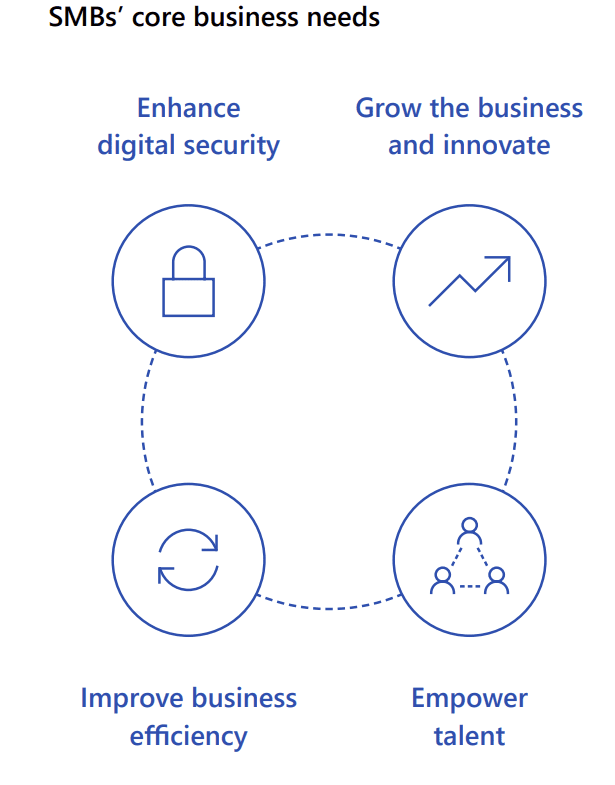Many small and medium-sized businesses (SMBs) are struggling because of rising costs, post-pandemic supply chain issues, increased cybersecurity threats, and more. However, embracing digital technologies can help them overcome these challenges.
Each organization’s digital journey will be different, but it is important to adapt and evolve to thrive in today’s rapidly changing world. Nearly 65% of SMBs want to buy a suite of software that meets all their needs. Microsoft partners have a great opportunity to help customers by showing them how the Microsoft platform can work for them.
4 key areas SMBs should focus their efforts

Enhance digital security
Digital security is more important than ever because hackers are becoming more skilled, and in the hybrid work environment, people are using their devices for work and personal activities.
SMBs will continue to spend on cybersecurity for preventing malicious attacks and protecting important data assets. They will look for comprehensive end-to-end platform solutions that support security, compliance, identity, management, and privacy. Additionally, they can use managed services to help them remotely manage their employees’ mobile devices and security and storage.
Grow the business and innovate
SMBs can make use of digital marketing automation; low-code and no-code tools; and better customer relationship management (CRM) and enterprise resource planning (ERP) solutions, to attract new business and drive innovation.
Empower talent through hybrid work
70% of digitally enabled SMBs will operate under a hybrid working model.
SMBs will recognize that fully remote or hybrid working arrangements are not just a pandemic-related aberration. They will continue to invest in collaboration solutions to support working from home, building on the solutions put in place over the past two years.
SMBs need to give their employees good tools and technology to do their jobs, whether they are working in the office or remotely. They also need to invest in making sure their employees have the digital skills they need to be happy and productive in their jobs. This will help with the talent shortage.
Improve business efficiency
To improve their operational efficiency, SMBs will invest in digital transformation initiatives that involve moving their on-premises workloads (such as servers, storage, and networking) to the cloud. In 2023, two-thirds of their spending on business applications will come from Software-as-a-Service (SaaS) solutions.
How can Microsoft partners help SMBs achieve their goals?
Many SMBs will turn to IT service providers for trusted advice and guidance. There is an opportunity of A$16 billion for partners in Australia and New Zealand, but they may need to evolve their offerings to meet the needs of SMBs in a commercially beneficial way.
Microsoft partners have a lot of opportunities to expand their business and create unique value propositions for SMBs. There is a need to grow the Microsoft partner ecosystem to meet customer demand by helping existing partners expand their reach and adding new partners.
Here are 5 ways by which partners can aid SMBs in their digital transformation.
- Deliver cross-cloud solutions
Microsoft wants to provide the benefits of using its Cloud technology to every SMB. A lot of small businesses have been using different technology solutions from different vendors. But with Microsoft’s comprehensive technology stack, they can do more with fewer solutions.
Consolidating with Microsoft 365 eliminates redundant solutions. Thereby SMBs can cut down licensing costs by as much as 60% as compared to a patchwork of point solutions. They will be able to automate system updates and reduce IT management costs by 40% and time spent on device management by 24%. SMBs can enhance digital security using the zero-trust security model and reduce data breach risk by 45% and identity and access management costs by 50%.
- Expand services with security as a priority
Partners have a growing opportunity to offer more services to their customers. These services include data, AI, analytics, and business applications. In order to keep up with customer needs, traditional MSPs will need to add these complementary workloads.
SMBs are increasingly concerned about cybersecurity threats and the risks they pose. 90% of customers will switch IT partners if they are offered better security. Security, governance, and compliance remain essential partner offerings.
- Package intellectual property to drive profitability
Partners can develop and package the intellectual property (IP) around the ways they use Microsoft solutions and thereby build unique and scalable customer offerings. This IP can range from methods of automating business processes using Power Automate to sophisticated, industry-aligned solutions that are built on Microsoft’s cloud services. These solutions create customer value and improve partner revenue and customer stickiness.
Packaging this IP makes it possible to build a solution once and then apply it to other use cases or other customers and earn recurring revenue.
- Leverage Microsoft’s partner ecosystem and app marketplace
Being a part of the Microsoft partner ecosystem opens the opportunity to work with other Microsoft partners. These partners can help you deliver complex solutions, reduce your overheads and expand your SMB offerings.
There are several Microsoft-fuelled apps on the Microsoft app marketplace. Partners can support customers’ end-to-end needs by plugging in complimenting apps to their Microsoft platform. This will offer a seamless and secure experience for customers.
- Unlock digital-first SaaS, ISV customers
The largest customer opportunity by total addressable market (TAM) is start-ups and digital-first businesses. Most of these are independent software vendors (ISVs) operating under the software-as-a-service (SaaS) model.
Services Partners are helping ISVs modernize and build the next generation of intelligent solutions, which makes them one of the fastest-growing segments.
Source: Microsoft
Read next: Microsoft to have 100% electricity consumption come from zero-carbon energy sources by 2030








